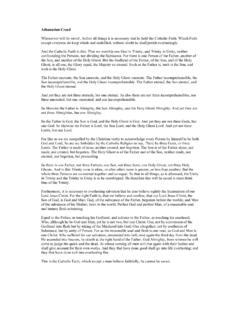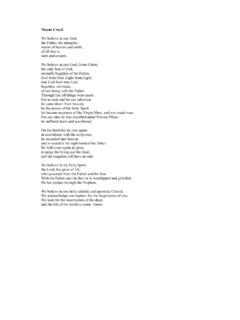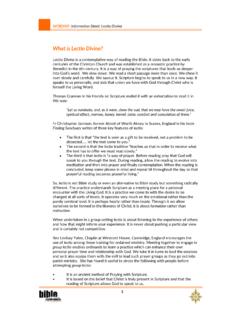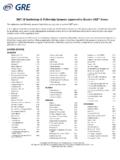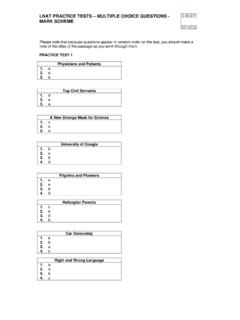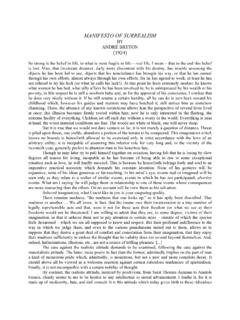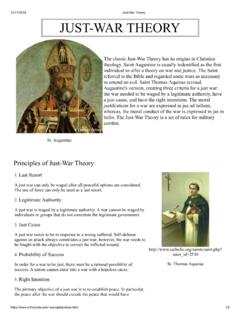Transcription of What do Anglicans Believe? - Anglican Communion
1 What do Anglicans Believe? A Study Guide to Christian Doctrine from Anglican and Ecumenical StatementsTheological Education in the Anglican Communion (TEAC)2020 What do Anglicans believe? A Study Guide to Christian Doctrine from Anglican and Ecumenical StatementsFirst edition. Published July 2020 Theological Education in the Anglican Communion TEAC Copyright The Anglican Consultative Council 2020 This publication may be downloaded, copied, used and distributed in its entirety without charge; but no commercial exploitation, including selling or hiring for a fee, is use of extracts for education purposes is permitted free of charge provided that the following credit line (including URL) is used in full: What do Anglicans believe?
2 A Study Guide to Christian Doctrine from Anglican and Ecumenical Statements is copyright The Anglican Consultative Council 2020 and is used with permission. The Anglican Consultative Council Saint Andrew s House 16 Tavistock Crescent London W11 1AP United KingdomISBN: 978-1-913863-00-5 What do Anglicans Believe? 3 ContentsIntroduction ..5I. What is Doctrine? ..8 Resources for Judging1. Where does doctrine sit in the life of the church? ..102. Where does doctrine come from? ..113. How is doctrine handed on? ..124. How has doctrine been revived in recent decades? ..125. Why engage in dialogue about doctrine? ..146. Can churches learn doctrine from each other? ..157. Is there a need to find new ways to express doctrine?
3 16II. What is the Doctrine of the Creeds? ..18lll. What is the Church? ..21 Resources for Judging1. Where to begin? ..232. What is the calling of the Church?..243. How is the Church one? ..254. How is the Church holy? ..295. How is the Church catholic? ..316. How is the Church apostolic? ..327. What is the place of the Sacraments? ..358. What is Communion ? ..389. How to sum up? ..39 Recommended Further Reading ..43 List of Anglican and Ecumenical Statements ..44 What do Anglicans Believe? 4 What do Anglicans Believe? 5 IntroductionIn his great set of poems The Four Quartets Eliot describes how we can have an experience but miss the meaning. This can be as true for theological students as anyone else: they can become so preoccupied with the practicalities of ministry and church life that they lose touch with the meaning of what it is all about.
4 Spending time in study of the doctrines of the Christian faith, the beliefs which undergird all that we do, can make all the difference. This study guide provides an opportunity for students to do this, with the help of Anglican and ecumenical texts freely available on the internet, not least for those across the Anglican Communion who do not have access to theological libraries. Furthermore, as Eliot goes on to say, finding the meaning restores the experience in a different form. The study guide builds on the dialogue about doctrine that Anglican churches have had with each other and with other churches across the world ever since they were formed. Over recent decades these conversations have produced a rich and authoritative collection of agreed statements, written by Anglican theologians in partnership with theologians from other churches, to create a broad and rich map of the Christian faith as it has been received and handed on by these churches.
5 In this study guide, then, taking advantage of the availability of these statements from various websites, a concise and well-grounded introduction to Christian doctrine is assembled for use in home groups, study programmes, seminaries and theological colleges across the Anglican Communion . It has been produced by members of the Inter Anglican Standing Commission on Unity, Faith and Order (IASCUFO) working in partnership with the Anglican Communion s department of Theological Education in the Anglican Communion (TEAC). It has been compiled to be uploaded onto the theological education pages of the Anglican Communion website, to be freely available for use by all. To help readers engage with the texts the study guide uses an interactive approach, with questions and answers running through every chapter.
6 It begins with broad questions, namely what is doctrine in general and what is the doctrine shared by all historic churches, and from there narrows down to specific Anglican doctrine. The first chapter looks at the nature of doctrine in general, introducing its place within discipleship and mission as a whole. The second chapter turns to the doctrines of the Nicene Creed, the most ancient and widely used creed today, shared by churches of both East and West, South and North, using a recent and widely welcomed ecumenical text that unpacks and applies its meaning for today. This chapter will offer a structure for engaging with it. The third and longest chapter turns to the doctrine of the What do Anglicans Believe?
7 6 Church, drawing on a rich selection of Anglican and ecumenical ecclesiological statements, to approach this topical and important subject from a number of directions, also touching on the nature of the sacraments. Agreed statements, however, only take us so far. They need to be not only read but understood, interpreted and expressed in worship, mission and discipleship. There need to be moments when the penny drops and the meaning of doctrines becomes clear and energising and we go on to express them in our of this will be very different in different places, depending on the social and cultural realities of the respective context. Each study group will find its own way of doing these things, at a level and in a way that is appropriate for them.
8 The person leading the study process will need to be sensitive to these dynamics and fashion the study accordingly. To help with this, this study guide draws on an approach to learning often described as See-Judge-Act , or Taking in, Taking stock, Taking action .1 It is a simple but effective three-step method of reflection and action which moves from the learner s context to the text in question and then to a practical response, to be repeated again and again:1 See, for example, Simon Cuff, Love in Action: Catholic Social Teaching for Every Church, London: SCM Press, Chapter 8: See, Judge, Act . Cuff traces the origins of this approach back to St thomas aquinas . On Taking in, Taking stock and Taking action see God s Justice: Just Relationships between Women and Men, Girls and Boys: Study Materials for use by Theological Colleges, Seminaries and Training Schemes in the Anglican Communion , Section 2, , Anglican Communion Office 2019, These approaches are similar in some respects to the pastoral cycle found in much recent pastoral and practical first step is all about coming to see the situation in which we find ourselves our context.
9 Such an analysis will ask what is happening, who is involved, and what are its effects. In this case, with doctrine as the subject, the questions will be about what is the current role of doctrine (or specific doctrines) in the life of our church (whether local or regional), who is involved in that role, and what effect does it have. This first step of the pedagogical process requires a degree of social analysis and is best done as a group exercise, involving those who share this reality and who can analyse it together. JudgeThe second step is all about gaining a critical perspective on the subject, by learning from authorities such as scripture, church teaching and scholarship, and comparing and contrasting what is currently the case in our context with what could and should be the case.
10 As far as doctrine is concerned, this step involves reading and learning from authoritative ecumenical and Anglican statements, on the meaning and place of doctrine and specific doctrines in the life of the church, and then reflecting on how the situation uncovered by the first step What do Anglicans Believe? 7is positively critiqued by this. What changes and growth in understanding of doctrine, and specific doctrines, could and should be made, and how could they find more authentic and inspiring expression in our Christian lives? Most of the contents of this study guide is to resource this second response to the critical perspective on church life gained in the second step, the third step is all about deciding how in practice we are going to bridge the gap between what is happening and what should be happening.


